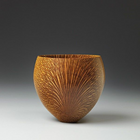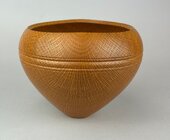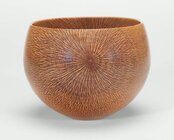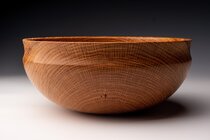-
It's time to cast your vote in the April 2025 Turning Challenge. (click here for details) -
Congratulations to Steve Bonny for "A Book Holds What Time Lets Go" being selected as Turning of the Week for 28 April, 2025 (click here for details) -
Welcome new registering member. Your username must be your real First and Last name (for example: John Doe). "Screen names" and "handles" are not allowed and your registration will be deleted if you don't use your real name. Also, do not use all caps nor all lower case.
You are using an out of date browser. It may not display this or other websites correctly.
You should upgrade or use an alternative browser.
You should upgrade or use an alternative browser.
How was this blank cut from a "log" to get this pattern?
- Thread starter Randy Heinemann
- Start date
Incredible medullary ray patterns! I have not seen that in oak before, at least not that spectacular. To get the ray patterns, you need to quarter saw the blank. That may be a piece of lace wood, some times called silky oak. Don't know if it is really an oak or not. I think Leopard wood is a similar but heavier wood. That does look like the pith near the bottom. I have had some sycamore that has beautiful ray flecking, but on a hollow form, it is only on 2 sides of the vase. Not sure exactly how that one was cut.
robo hippy
robo hippy
Not sure of the exact species, but it looks like Macadamia,,or something similar. Gorgeous stuff.
It’s true that medullary rays show themselves when quarter sawn, but in the case of a bowl one comes extremely close to quarter sawn in the sides. This is true when the pith is positioned at the bottom, bowl facing straight out from the tree. My definition of quarter sawn is from the pith straight to the edge. So a cone shape would be ideal, but ugly. This elliptical shape hits both beautiful form and lots of rays.
It’s true that medullary rays show themselves when quarter sawn, but in the case of a bowl one comes extremely close to quarter sawn in the sides. This is true when the pith is positioned at the bottom, bowl facing straight out from the tree. My definition of quarter sawn is from the pith straight to the edge. So a cone shape would be ideal, but ugly. This elliptical shape hits both beautiful form and lots of rays.
Very nice Brent. It appears that, with yours, you did the reverse and hollowed out the pith rather than what was done with the bowl in the picture I posted. I've seen the bowl in my picture numerous times and am going to attempt to do it but the pith inclusion kind of concerns me. I have some oak (white I think) from a friend's tree and wanted to make some pieces for him and his wife from the oak. Just unsure how to cut the logs apart to get the same effect.
It appears to me the piece was cut from the whole log section, with the pith slanted 10-20 deg off center - the blank may have been trimmed “at the corners” before mounting, likely between centers, to true up and cut a tenon.Just unsure how to cut the logs apart to get the same effect
So...It's and endgrain bowl or essentially a hollow form? My concern is that the pith won't hold up in oak. If it's macadamia, I'm not sure where to get that. Plus, turning it from wood other than the tree the oak came from wouldn't yield a piece for my friend from his tree.It appears to me the piece was cut from the whole log section, with the pith slanted 10-20 deg off center - the blank may have been trimmed “at the corners” before mounting, likely between centers, to true up and cut a tenon.
It appears that the pith being positioned at the bottom could have been from an oblong branch. Some species grow rounder than others, and some can have a very offset pith. I wonder if that is why the rays appear to burst upwards, and below, they are slightly compressed?
Not an end grain bowl. It’s side grain, but without splitting the log into halves prior to turning. If the form is turned thin enough and with a generous, smoothly flowing curve, the wood around the pith will flex instead of cracking. More stable woods will be better for this type of work.
The offset pith in the photo and the asymmetric ray pattern probably indicate that a branch was used. Branch piths are typically located closer to the top of the branch to compensate for the stresses in horizontal growth.
The offset pith in the photo and the asymmetric ray pattern probably indicate that a branch was used. Branch piths are typically located closer to the top of the branch to compensate for the stresses in horizontal growth.
I am drooling over the macadamia nut wood!
robo hippy
robo hippy
So...It's and endgrain bowl or essentially a hollow form? My concern is that the pith won't hold up in oak. If it's macadamia, I'm not sure where to get that. Plus, turning it from wood other than the tree the oak came from wouldn't yield a piece for my friend from his tree.
The pith is often misunderstood. Once you turn through it, the stress is mostly relieved. There will still be some tension, but usually not enough to cause issues. I leave the pith in on a lot of turnings.
My thought is that the pith "axis" is not running through the bowl parallel to the table surface. Rather it is running at an angle such that the pith emerges from the bowl on the far side much closer to the rim.
This would allow the medulary rays to run more parallel to the side of the bowl. The effect is further enhanced as the bowl shape is a flatter curve in the lower 2/3 of the form.
This would allow the medulary rays to run more parallel to the side of the bowl. The effect is further enhanced as the bowl shape is a flatter curve in the lower 2/3 of the form.




